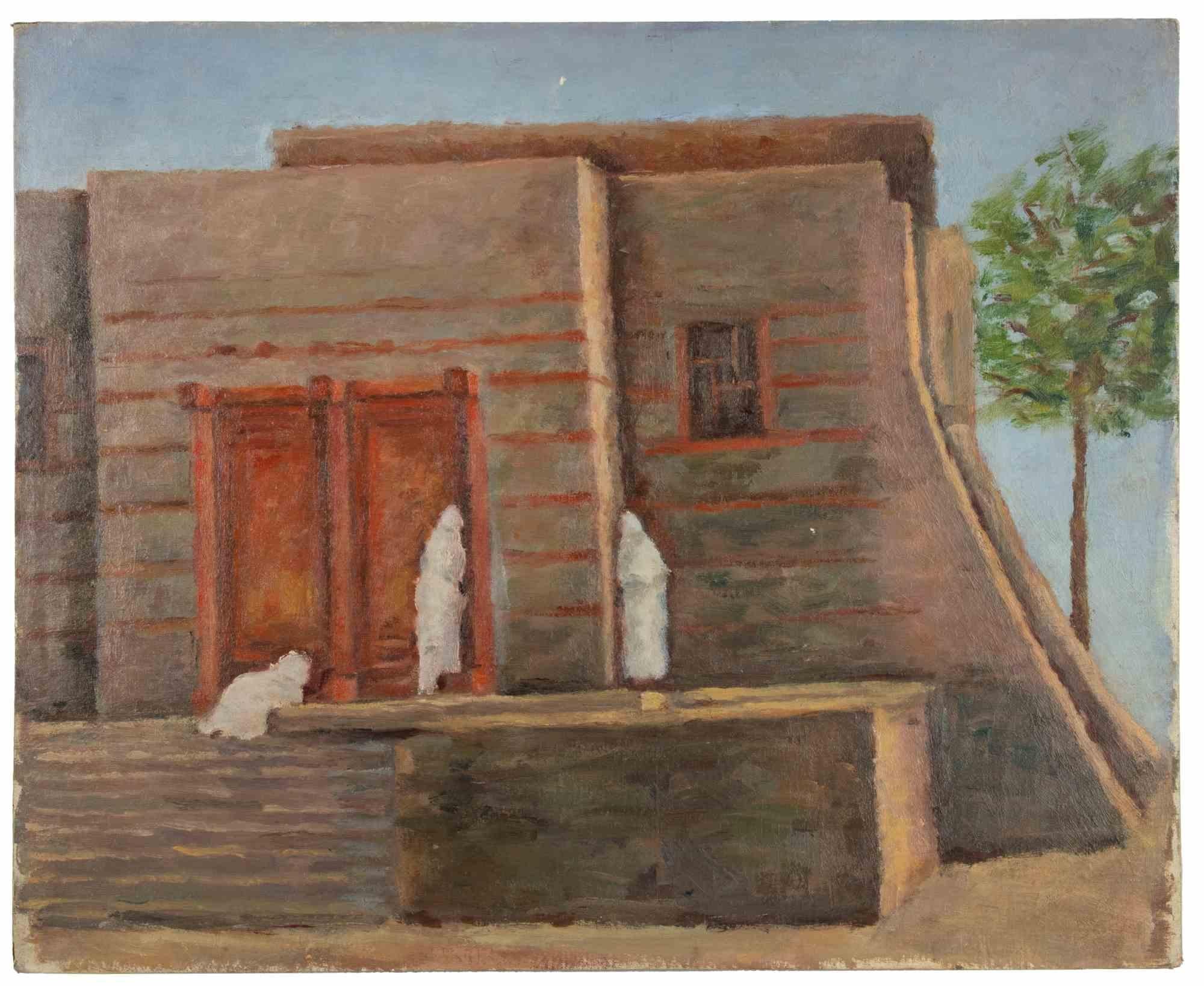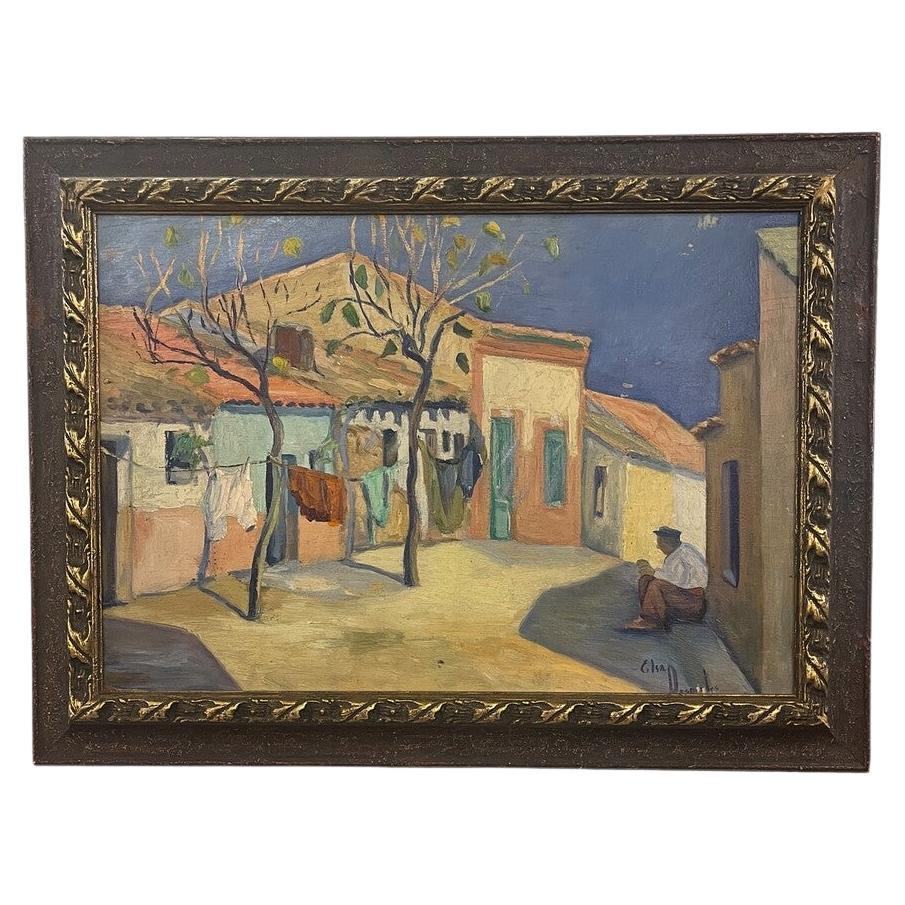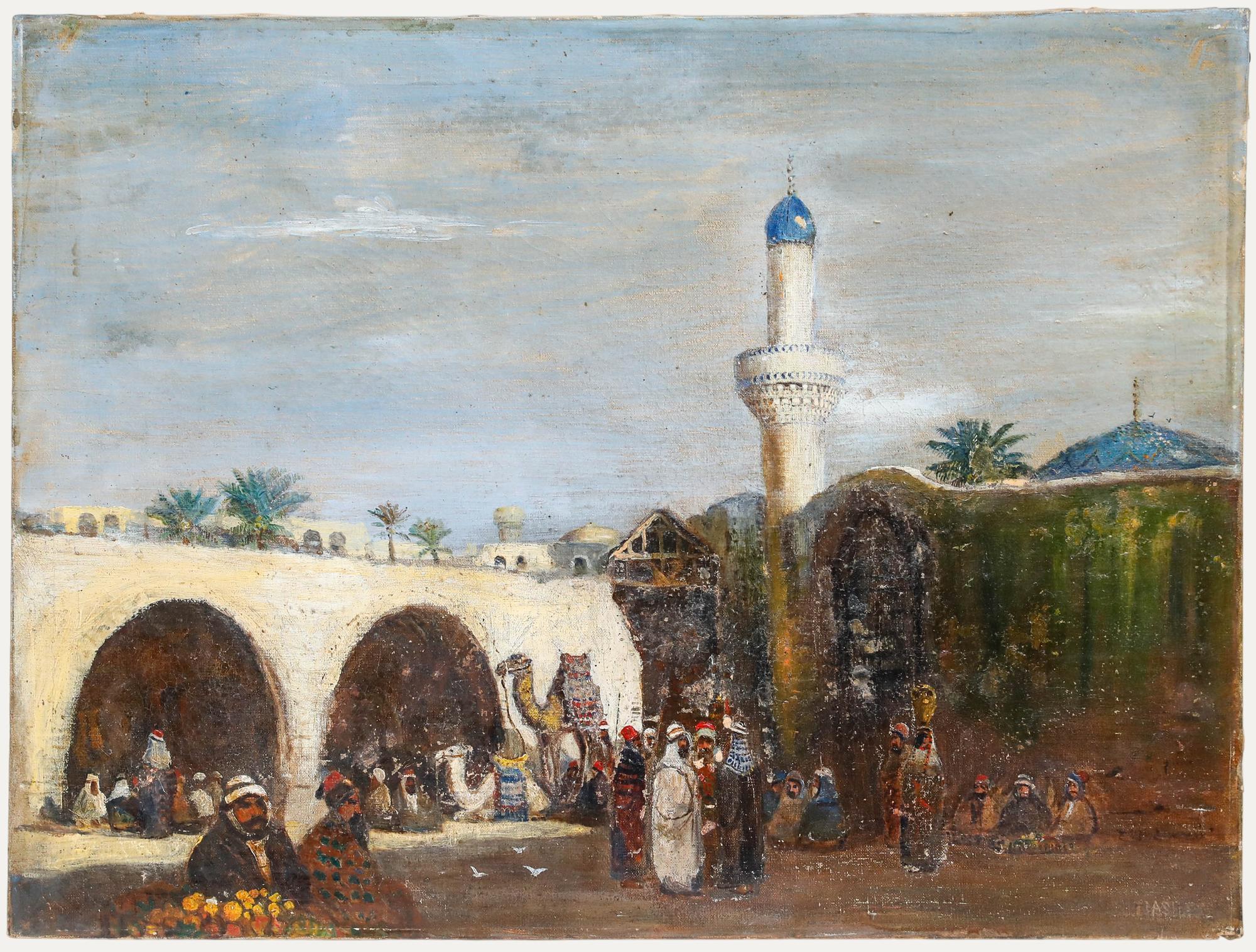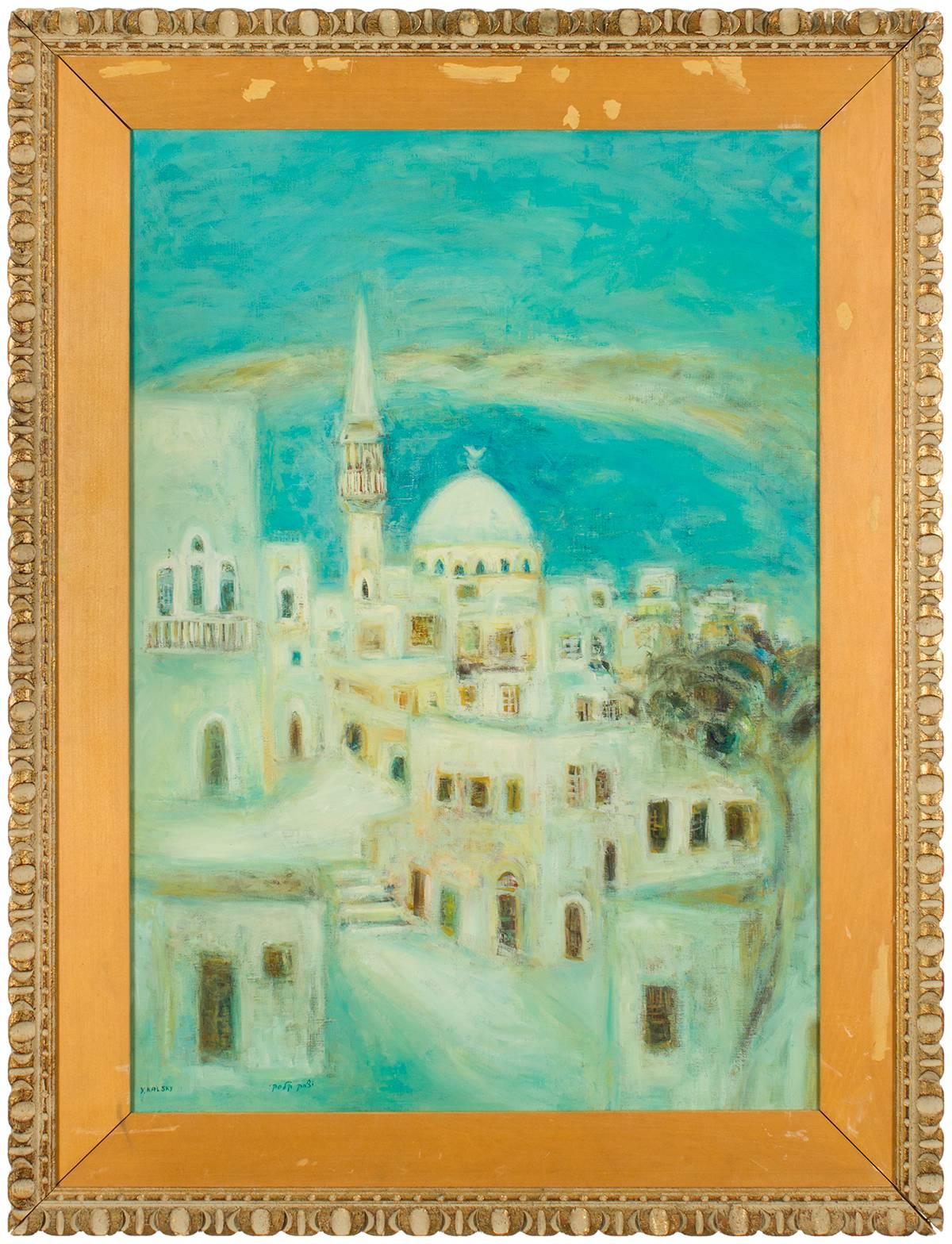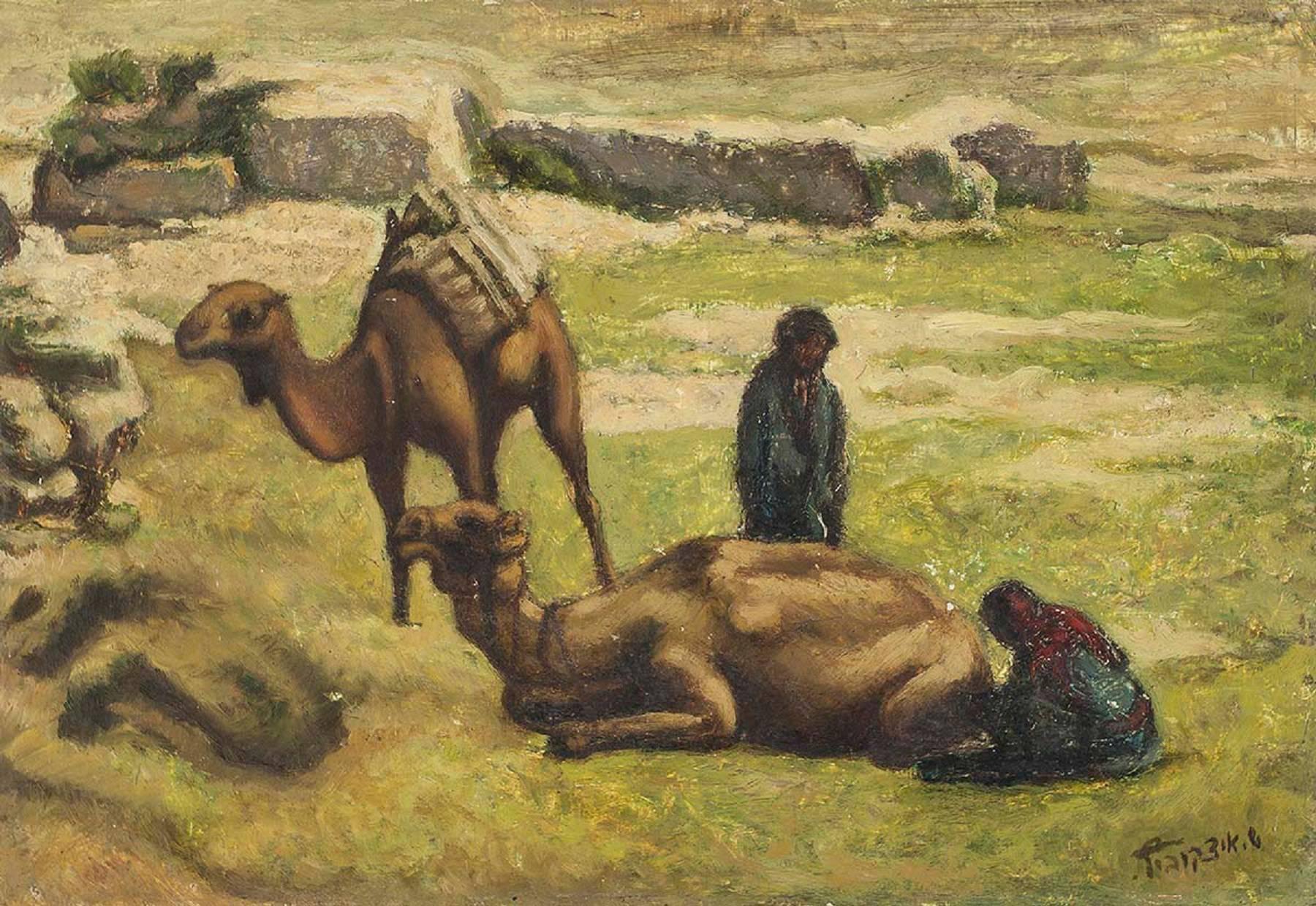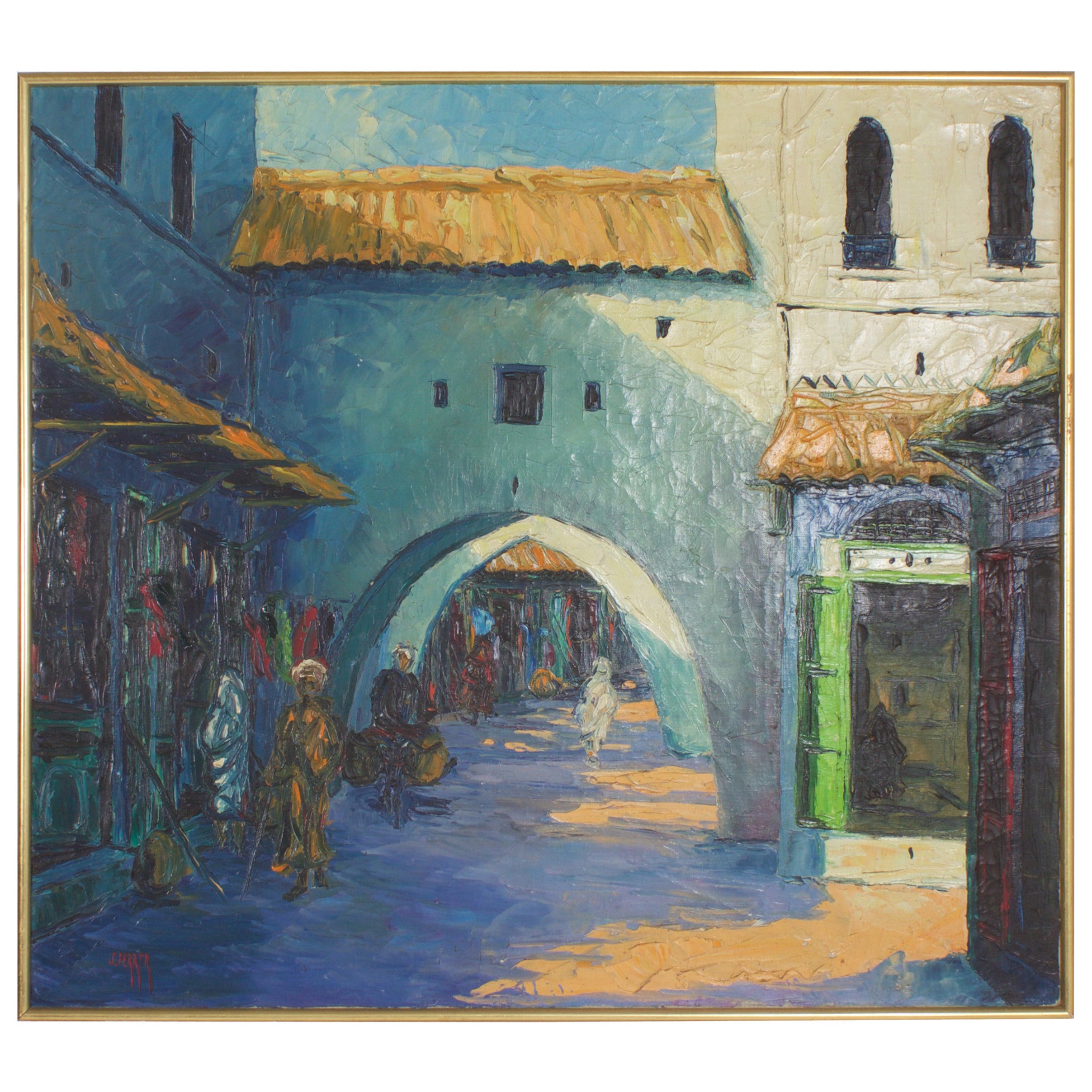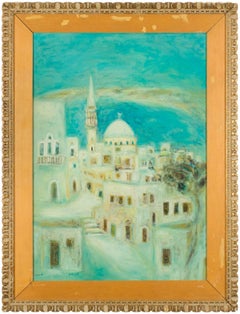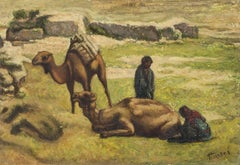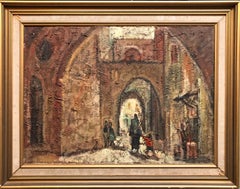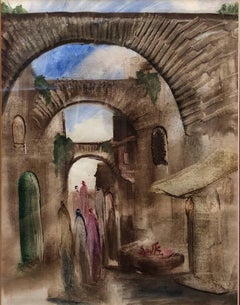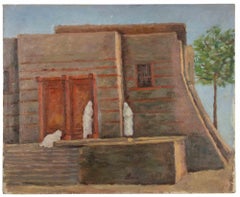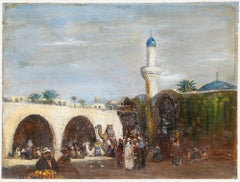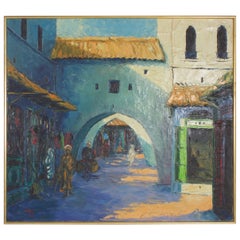Items Similar to Jewish Village Palestine/Israel C.1930s Modernist Painting
Want more images or videos?
Request additional images or videos from the seller
1 of 6
Ida Shelesnyak MirrofJewish Village Palestine/Israel C.1930s Modernist Painting
$1,200
£902.89
€1,042.86
CA$1,695.91
A$1,840.32
CHF 975.21
MX$22,570.68
NOK 12,068.15
SEK 11,403.76
DKK 7,785.44
About the Item
Bezalel School Period.
Genre: Judaica
Subject: People
Medium: Oil
Surface: Canvas
Dimensions: 16" x 20"
- Creator:Ida Shelesnyak Mirrof (1909 - 1988, American)
- Dimensions:Height: 16 in (40.64 cm)Width: 20 in (50.8 cm)
- Medium:
- Movement & Style:
- Period:
- Condition:has some staining verso and some wear to surface.
- Gallery Location:Surfside, FL
- Reference Number:1stDibs: LU38211680722
About the Seller
4.9
Platinum Seller
Premium sellers with a 4.7+ rating and 24-hour response times
Established in 1995
1stDibs seller since 2014
1,807 sales on 1stDibs
Typical response time: 1 hour
- ShippingRetrieving quote...Shipping from: Surfside, FL
- Return Policy
Authenticity Guarantee
In the unlikely event there’s an issue with an item’s authenticity, contact us within 1 year for a full refund. DetailsMoney-Back Guarantee
If your item is not as described, is damaged in transit, or does not arrive, contact us within 7 days for a full refund. Details24-Hour Cancellation
You have a 24-hour grace period in which to reconsider your purchase, with no questions asked.Vetted Professional Sellers
Our world-class sellers must adhere to strict standards for service and quality, maintaining the integrity of our listings.Price-Match Guarantee
If you find that a seller listed the same item for a lower price elsewhere, we’ll match it.Trusted Global Delivery
Our best-in-class carrier network provides specialized shipping options worldwide, including custom delivery.More From This Seller
View AllLarge Polish Israeli Landscape Mid Century Oil Painting
Located in Surfside, FL
Genre: Modern
Subject: Cityscape
Medium: Oil
Surface: Canvas
Country: Israel
Dimensions: 36 1/4" x 25 3/4" x 3/4"
Dimensions w/Frame: 44 3/4" x 34"
Rare Modern Mid Century Israel landscape...
Category
20th Century Modern Landscape Paintings
Materials
Canvas, Oil
Pastoral Landscape Palestine/Israel Camels and Shepherds
By Shlomo Itzkovitch
Located in Surfside, FL
Shlomo Itzkowitch, Israeli, born Poland, 1896-1973.
Shlomo Itzkowitch was born in Lodz, Poland. He studied painting in his hometown. In 1918-1925, he moved to Germany and was active...
Category
20th Century Figurative Paintings
Materials
Oil, Board
Jerusalem Old City Cityscape Israeli Modernist Oil Painting Signed in Hebrew
Located in Surfside, FL
Signed Nathanson. Could be the famous artist Avraham Naton (Natanson) I am not certain. it is a very lovely Modernist Israeli landscape.
Avraham Naton (Natanson), Israeli, born in Bessarabia, 1906-1959. Avraham Naton was born in Rani, Bessarabia to a large secular family. In 1935, after Art studies in Romania, he immigrated to the Land of Israel and settled, first, in Givat Haim and later in Ramat Gan. From the 1940s he worked as an Art teacher in Ramat Gan and Givataim. In 1948 he worked as an illustrator at BaMahane Newspaper. He was one of the Founders of New Horizon Group. Between 1952-1959 he was a member of the Milo Club and served as the club secretary.
Education
1930-33 Art Academy, Bucharest, Romania
Teaching
1940's Ramat Gan and Givataim
Awards And Prizes
Jerusalem Prize for Painting and Sculpture
1942 Dizengoff Prize
1953 Milo Club Prize
New Horizons, The Ofakim Hadashim art movement began with a group of artists who mounted an exhibition in Tel Aviv's Habima national theater in December 1942, under the name "The Group of Eight". The group evolved into a coherent artistic movement only after the founding of the state of Israel in 1948. Members of the school included Arie Aroch, Zvi Meirovitch, Avraham Naton (Natanson), Avigdor Stematsky and Yehezkel Streichman. The work of sculptor Dov Feigin also appeared in the catalog of the 1942 exhibition, though it was not displayed. In February 1947 five of the original members of the group joined Joseph Zaritsky...
Category
1950s Modern Landscape Paintings
Materials
Canvas, Oil
Jerusalem Old City Landscape, Expressionist Judaica Israeli Painting
By Andre Elbaz
Located in Surfside, FL
In this painting the artist uses gestural brushstrokes, which causes distortion and exaggeration for emotional effect. Andre Elbaz uses as his subject figures walking in old city Jerusalem.
André Elbaz (born April 26, 1934, El Jadida, Morocco) is a famous Moroccan painter and filmmaker.
Elbaz studied art and theatre in Rabat and Paris from 1950 to 1961. He started painting only at the age of 21, until which age he had been interested mainly in theatre. A few years later, he managed to combine his two passions into a new approach in art-therapy, inventing together with his wife, a psychiatrist, the Pictodrame, which brought him world recognition.
His first exhibition, which was very successful, took place in Casablanca in 1961 and earned him an appointment as Professor at the Beaux-Arts school in Casablanca. Years later, in 1976, he exhibited his paintings at the Tel-Aviv Museum.
In parallel to his career as a painter, Elbaz is also known as a filmmaker. He produced several short films in France, Canada and the United States. One of them, La nuit n'est jamais complète (The night is never complete), won a prize at the "5th Biennale de Paris in 1967". Among the themes chosen for the many films he produced, there was a short one about the Warsaw Ghetto uprising, as well as a series of drawings entitled Seuls (Alone), with texts written by both Elie Wiesel...
Category
20th Century Expressionist Figurative Paintings
Materials
Paper, Gouache
Rabbi in Jerusalem Modernist Israeli Judaica Oil Painting Arie Alweil Viennese
By Arieh Allweil
Located in Surfside, FL
ARIEH ALLWEIL [ARIE ALWEIL] 1901-1967
Galicia 1901-1967 Safed, Israel (Ukranian/Polish/Israeli)
Arieh Allweil, born 1901, Galicia. Immigrated to Palestine in1920. Studies: 1921-25 Art Academy, Vienna; Dresden Academy. ALlweil brought with him the high values of the Central European avant-garde, which he had absorbed during his years of study in Vienna. He joined the ‘Kunstschau’ group- of artists that had formed around Gustav Klimt and Egon Schiele. He exhibited with them in the 1920’s, and emigrated to Palestine in 1926. He was one of the founders of the Tel Aviv Art Museum and the Midrasha Art Teachers College in Israel. As opposed to other modern Israeli artists in his period, Allweil's woodcuts and illustrations pertained to contemporary events such as the Holocaust and the pioneering spirit before the establishment of the State of Israel. Most notable is this work as well as the first illustrated Passover Haggada for the IDF which he made in 1950 and which was printed for 3 years with his inspirational woodcut illustrations. He published a series of linoleum cuts of Israeli and Biblical subjects and created large scale murals of the Holocaust.
Teaching: In Israel, art. Prizes: Received Dizengoff Prize twice; 1955 Turov Prize for Bible Illustrations. Published series of linoleum cuts of Israeli and Biblical subjects, also illustrated a Passover Haggada and large scale murals of Holocaust. From 1952 until his death lived in Tel Aviv and in Safed in summer. Died 1967, Safed.
Education
1921-25 Art Academy, Vienna, Austria
1921-25 Dresden Academy, Germany
Teaching
Herzliyah Gymnasium High-School, Israel, art.
Tel Aviv High School
Awards And Prizes
1937 Dizengoff Prize for Painting and Sculpture,
Tel Aviv Museum of Art, Municipality of Tel Aviv-Jaffa
1946 Dizengoff Prize
1955 Turov Prize for Bible Illustrations
Select Solo Exhibition:
1933 Tel Aviv Museum, Solo Exhibition
1942 Katz Gallery, Tel Aviv
1950 Tel Aviv Museum, Tel Aviv
1956 The Blue Dome, Safed
1968 Memorial Exhibition of the artist Arieh Allweil Yad Labanim Museum, Petach-Tikva
1969 Solo Exhibition The Knesset, Jerusalem
1987 Arieh Allweil: 1901-1967 - ''Return to Betanya Ilit'' Beit Gabriel, Zemah
1994 Arieh Allweil: Prints and Caligraphy The Isaac Kaplan Old Yishuv Court Museum,Jerusalem
2011 Arieh Allweil, Letters, Figures, Landscapes
Mishkan Le'omanut, Museum of Art, Kibbutz Ein Harod
Select Group Exhibitions
1929 Eged - Palestine Painters Group Allenby Street, Tel Aviv
Artists: ChanaOrloff, Abraham Melnikoff, Reuven Rubin, Nachum Gutman, Sionah Tagger, Arieh Allweil, Haim Gliksberg, Yossef Zaritsky, Leon Arie Fein, Pinchas Litvinovsky, Elias Newman.
1932 The Bezalel National Museum, Jerusalem
Artists:
Litvinovsky, Pinchas Gutman, Nachum Allweil, Arieh
Exhibition of Artists: P. Litvinovsky, A. Allweil, N. Gutman
1936 First Exhibition of ''Hever Omanim'' Steimatzky Galleries, Jerusalem
Artists:
Gutman, Nahum Holzman, Shimshon Moshe Mokady, Miron Sima, Jakob Steinhardt, Zeev Ben Zvi, Moshe Ziffer, Allweil, Arieh.
1944 Collective Annual Exhibition by Palestinian Artists
Art Gallery of the ''Habima'' Building, Tel Aviv
Artists:
Hermann Struck, Hermann Moshe Sternschuss, Arie Reznik, Aaron Priver, Itzhak Danziger, Itzhak Zvi Aldouby, Menahem Shemi...
Category
20th Century Modern Figurative Paintings
Materials
Canvas, Oil
Judaica Oil Painting Jewish Family Interior Shtetl Scene
By Peter Horowitz
Located in Surfside, FL
Peter Horowitz, painter, born 1922, Poland. Lived in Hod Hasharon in Israel.
Studied at the Art Academy, Krakow. died in 2005.
Studies: Art Academy, Cracow. Peter Horowitz was born...
Category
Mid-20th Century Modern Figurative Paintings
Materials
Oil, Board
You May Also Like
House in the Desert - Painting by Francesco Settimj - mid-20th Century
Located in Roma, IT
Oil on canvas mounted on cardboard.
Very good condition.
Category
Mid-20th Century Modern Figurative Paintings
Materials
Oil
Elsa Desportes Village Scene Oil on Board
Located in Houston, TX
Elsa Desportes Village Scene Oil on Board. Scene is from a village most likely in the 30's or 40's. She painted in Southern France, Morocco and Algeria. She died in 1990
Category
Mid-20th Century French Mid-Century Modern Paintings
Materials
Wood, Paint
Early 20th Century Oil - Middle Eastern Street Scene
Located in Corsham, GB
A charming early 20th century oil depicting a Middle Eastern street scene dominated by a towering minaret and ancient stone archways. The artist naively portrays a diverse crowd bene...
Category
20th Century Landscape Paintings
Materials
Oil
Middle Eastern Building Painting
Located in Palm Beach, FL
Mid Century acrylic on canvas painting of a Middle Eastern Street scene executed with bold impressionistic brush strokes. Depicting exotic Architecture ...
Category
Mid-20th Century Unknown Mid-Century Modern Paintings
Materials
Paint
1950s Painting of a Street Scene with Figures & a Traditional Maghrebi Courtyard
Located in Marbella, ES
Oil painting on canvas depicting a lively urban scene in what appears to be a North African medina. In it, several figures dressed in traditional clothing walk or converse under the ...
Category
Vintage 1950s Moroccan Paintings
Materials
Canvas, Wood
Walter Cooksey - Framed Early 20th Century Oil, The Old Market Place, Jaffa
Located in Corsham, GB
This vibrant oil painting captures the bustling atmosphere of Israeli Jaffa, with figures engaged in trade activities amidst earth-toned buildings and a sun-drenched courtyard. The a...
Category
20th Century Figurative Paintings
Materials
Oil
More Ways To Browse
Jewish Antique
Israeli Antique
Palestine Antique
Antique Jewish Art
Jewish Oil Painting
1930s Modernist Painting
Surreal Nudes
Abundance Painting
Contemporary Cowboy Art
Contemporary Painting Car
Naive French Folk Art Painting
African Faces
Modern Judaica Painting
Red Bull
Surreal Figure
Army Painting
Classical Figurative Paintings
The Kiss Painting
